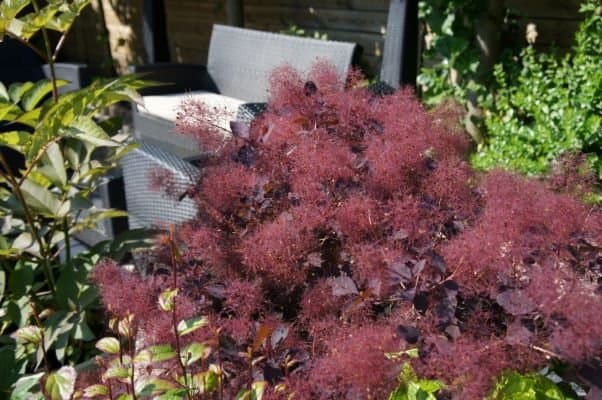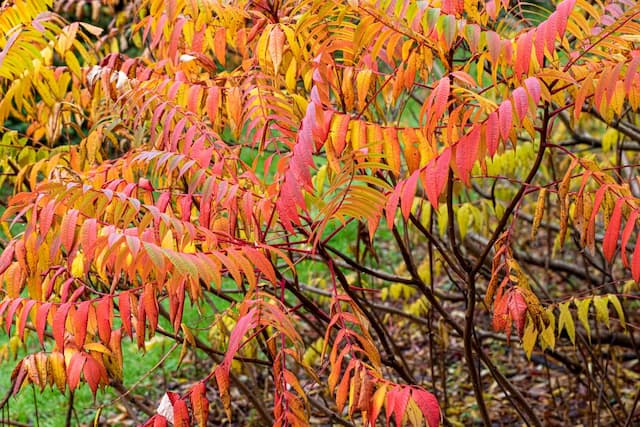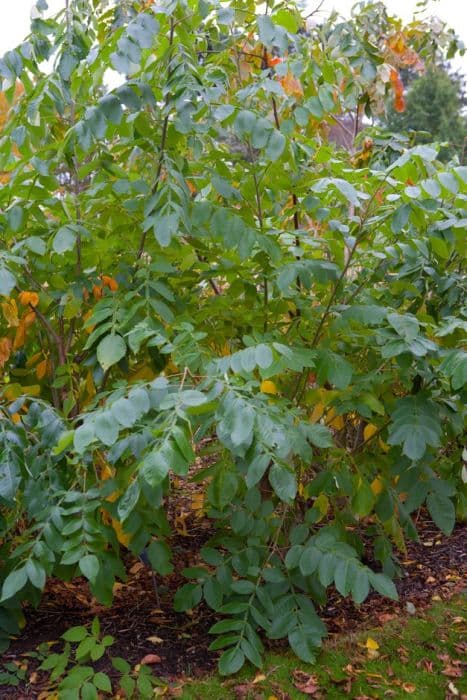American Smoke Tree Cotinus obovatus











ABOUT
The American smoketree, also known as Cotinus obovatus, is a visually striking plant known for its distinctive foliage and dramatic, smoke-like flower clusters. The leaves of the American smoketree are deciduous, meaning they shed seasonally, and have an appealing rounded to ovate shape which can display a range of colors through the seasons. They are initially a bright green and can turn to stunning shades of orange, red, and purple in the fall, creating a vibrant display. Adding to its beauty, the American smoketree produces airy, fluffy flower panicles which have a hazy, smoke-like appearance—hence the name "smoketree." These feathery blooms are typically a light, grayish-pink color, giving the plant a soft, ethereal look when they appear in the spring and early summer. The bark of the American smoketree is also notable for its aesthetic appeal. It tends to be gray to brown and can become ridged or scaly, adding texture and interest even when the branches are bare in the dormant season. The overall form of the American smoketree is irregular, which contributes to its unique character in the landscape. It is a plant that truly stands out for its beauty and the various interesting features it offers throughout the year.
About this plant
 Names
NamesSynonyms
American Smoke Tree, American Smoketree, Texas Smoke Tree, Wild Smoke Tree, Chittamwood, Smoke Bush, Smoke Wood.
Common names
Cotinus americanus, Rhus cotinoides
 Toxicity
ToxicityTo humans
Cotinus obovatus, commonly known as American smoketree, is not generally considered toxic to humans. There is limited information on the plant's toxicity, but it lacks a reputation for being poisonous. If any part of the plant were ingested in large quantities, it could potentially cause stomach discomfort or irritation as with many non-food plants, but this is not typical. No specific symptoms of poisoning from American smoketree have been widely reported or documented.
To pets
American smoketree, or Cotinus obovatus, is not commonly known to be toxic to pets either. There's a lack of evidence suggesting any part of the plant poses a significant risk when ingested by animals. As with most plants not intended for animal consumption, ingestion might lead to mild gastrointestinal upset such as vomiting or diarrhea, but serious poisoning is unlikely. Always monitor your pet's health and consult with a veterinarian if any unusual symptoms arise after ingestion of plant material.
 Characteristics
CharacteristicsLife cycle
Perennials
Foliage type
Deciduous
Color of leaves
Green
Flower color
Pink
Height
15-25 feet (4.5-7.6 meters)
Spread
10-20 feet (3-6 meters)
Plant type
Shrub
Hardiness zones
5-9
Native area
Southeastern United States
Benefits
 General Benefits
General Benefits- Ornamental Appeal - Cotinus obovatus, commonly known as American Smoke Tree, has showy, fluffy flower clusters creating a smoke-like effect.
- Seasonal Interest - It exhibits vibrant fall foliage with red, purple, and orange colors.
- Drought Tolerance - American Smoke Tree is well-suited to withstand periods of limited rainfall once established.
- Low Maintenance - It requires minimal care in terms of pruning or insect and disease management.
- Habitat Support - It provides food and shelter for various bird species.
- Native Adaptation - As a native species, it naturally thrives in North American climates and soil conditions.
- Erosion Control - Its root system can help stabilize soil and prevent erosion.
 Medical Properties
Medical Properties- There is currently no widely recognized medical use for Cotinus obovatus, also known as the American smoketree.
 Air-purifying Qualities
Air-purifying QualitiesThis plant is not specifically known for air purifying qualities.
 Other Uses
Other Uses- Cotinus obovatus, commonly known as American smoketree, can be used as a natural dye for fabrics, yielding a range of colors from yellow to orange, depending on the mordant used.
- The wood of the American smoketree is prized for small woodworking projects and inlay work, thanks to its unique color and grain patterns.
- The leaves and bark of American smoketree have been traditionally used to create landscape watercolor paintings due to their range of vivid colors.
- American smoketree's dense foliage can provide an effective privacy screen or windbreak in a garden or outdoor space.
- The wood of the American smoketree sometimes serves as a substitute for ebony in decorative woodwork due to its dark color when polished.
- Wood from the American smoketree may be used to make musical instruments like flutes or woodwinds, offering a distinctive appearance and tone quality.
- In floral arrangements, branches of the American smoketree can add texture and a unique aesthetic with their feathery blooms.
- The American smoketree is occasionally utilized in bonsai cultivation for its striking appearance and ability to be trained into miniature forms.
- The seeds of the American smoketree can be used as ornamental beads in jewelry-making after proper treatment and drilling.
- Craftsmen historically have turned to American smoketree for creating small decorative objects like bowls or picture frames, capitalizing on its durability and finish.
Interesting Facts
 Feng Shui
Feng ShuiThe American Smoke Tree is not used in Feng Shui practice.
 Zodiac Sign Compitability
Zodiac Sign CompitabilityThe American Smoke Tree is not used in astrology practice.
 Plant Symbolism
Plant Symbolism- Transformation: Cotinus obovatus, commonly known as American Smoke Tree, often symbolizes transformation due to its remarkable change in appearance throughout the seasons, displaying vivid foliage colors that metamorphose from purple to scarlet.
- Mystery: Its common name refers to the smoke-like, airy flowers it produces, which can give it an ethereal, mysterious presence in the landscape.
- Longevity: With its hardy nature, the American Smoke Tree represents longevity and endurance, reminding us of the constant presence of nature through changing conditions.
- Resilience: The species' ability to thrive on different types of soils and its drought tolerance are indicative of resilience and adaptability to life's varying circumstances.
 Water
WaterThe Smoke Tree prefers a deep watering method, which allows the soil to be moistened thoroughly. It's best to water this plant once a week, with about 1 to 1.5 gallons depending on the size of the plant and the weather conditions, especially during the growing season in spring and summer. During winter, reduce the frequency as the plant requires less water. Always check the topsoil for moisture, around 2 inches deep, before watering again as overwatering can lead to root rot. And for mature trees in landscapes, they often require less frequent watering due to more extensive root systems.
 Light
LightSmoke Trees thrive in full sun, meaning they should receive at least 6 hours of direct sunlight daily. The ideal spot for a Smoke Tree would be an area with unobstructed exposure to the sun, possibly with some light afternoon shade in extremely hot climates. However, they are adaptable and can tolerate some partial shade, but their foliage may not be as vibrant or plentiful without ample sunshine.
 Temperature
TemperatureThe Smoke Tree can withstand a range of temperatures but grows best when the climate is between 60°F and 75°F. It's hardy in USDA zones 4 through 8, which means it can survive minimum temperatures of -30°F to -20°F. Avoid planting in areas where temperatures regularly exceed 95°F, as the heat can stress the plant.
 Pruning
PruningPruning the Smoke Tree is generally done to maintain shape and promote dense foliage. It should be pruned in late winter or early spring before new growth begins. This plant can be pruned annually, and making cuts just above a set of buds will encourage bushier growth. If desired, it can also be pruned to form a single-stemmed tree or to remove any dead or crossing branches to foster a healthy structure.
 Cleaning
CleaningAs needed
 Soil
SoilThe best soil mix for American Smoketree (Cotinus obovatus) should be well-draining with a mix of loam, peat, and sand. Adjust the soil acidity to a pH of 5.0-7.5 to match the plant's preference for slightly acidic to neutral soil conditions.
 Repotting
RepottingAmerican Smoketrees (Cotinus obovatus) do not need to be repotted frequently and can be repotted every 3-5 years or when the root system has outgrown the current container.
 Humidity & Misting
Humidity & MistingAmerican Smoketree (Cotinus obovatus) is tolerant of various humidity levels and does best in moderate outdoor humidity but does not require special humidity conditions when grown indoors.
 Suitable locations
Suitable locationsIndoor
Provide bright light and well-draining soil for indoor American Smoketree.
Outdoor
Full sun to partial shade and well-drained soil suit American Smoketree well.
Hardiness zone
4-8 USDA.
 Life cycle
Life cycleCotinus obovatus, commonly known as American smoke tree, begins its life cycle with seed germination, which requires stratification to break dormancy. The seedling stage is characterized by the emergence of the cotyledons and initial roots. As it enters the juvenile phase, the sapling develops true leaves, which are obovate and arranged in a simple, alternate pattern, and begins to establish its woody stem. Following the juvenile stage, the plant reaches maturity and begins to flower, producing fluffy, smoke-like inflorescences that give the tree its common name; these are followed by small, oval drupes. The mature American smoke tree then enters a period of repeated seasonal growth, flowering typically in the late spring and early summer, and may live for several decades, contributing to its local ecosystem by providing food and habitat for wildlife. Eventually, after completing its life span, the tree will senesce and die, potentially leaving behind seeds to start the next generation.
 Propogation
PropogationPropogation time
Spring-Early Summer
The Smoke Tree, commonly known as Cotinus obovatus, can be propagated through various methods, but the most popular method is through softwood cuttings. This technique is usually performed in late spring or early summer when the plant's new growth is still flexible and not yet woody. To propagate by cuttings, select a healthy, non-flowering stem and cut a 4 to 6-inch length (10 to 15 cm), making sure it includes several leaf nodes. Strip off the leaves from the lower half of the cutting and dip the cut end into a rooting hormone powder to encourage root development. Then, insert the cutting into a pot filled with a moistened mix of half peat and half perlite or sand, ensuring at least two nodes are buried where roots will form. Cover the pot with a plastic bag to maintain humidity and place it in indirect light. Keep the soil consistently moist. Rooting typically occurs within 4 to 8 weeks, and once the cuttings have developed a healthy root system, they can be transplanted into individual pots or into a prepared garden location.




